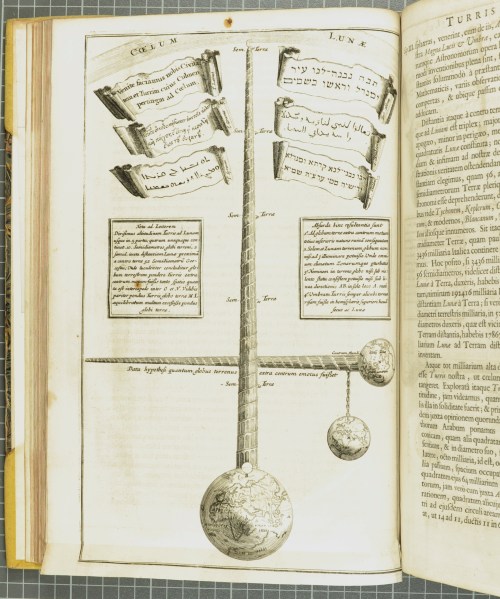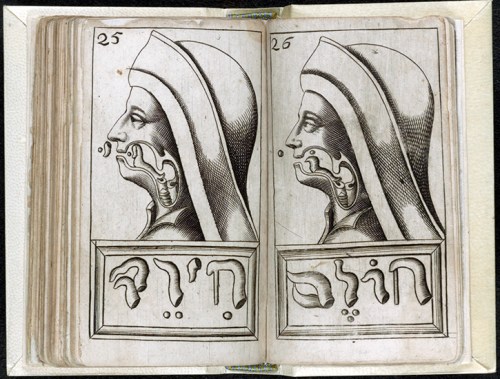Eco: The Etymological Furor, 2
by Estéban Trujillo de Gutiérrez

Athanasius Kircher (1602-80), Turris Babel, Amsterdam, 1679. The illustrations in Turris Babel were engraved by C. Decker. This copy is held by the University of St. Andrews, under call number 417f BS1238.B2K5. The librarian at St. Andrews, who signed himself simply as “DG,” quoted from a narrative posted on the site of the Museum of Jurassic Technology, recounting Genesis 10-11, in which Nimrod attempted to build a tower that reached the heavens. The Museum observes, “This model illustrates Kircher’s proof that Nimrod’s ambition was intrinsically flawed: in order to reach the nearest heavenly body; the Moon, the tower would have to be 178,672 miles high, comprised of over three million tons of matter. The uneven distribution of the Earth’s mass would tip the balance of the planet and move it from its position at the center of the universe, resulting in a cataclysmic disruption in the order of nature.” This work is in the public domain in its country of origin and other countries and areas where the copyright term is the author’s life plus 100 years or less.
“The thousand or so pages of Guichard are really little more than an extensive raiding expedition in which languages, dead and living, are pillaged for their treasures. More or less by chance, Guichard sometimes manages to hit upon a real etymological connection; but there is little scientific method in his madness.
Still, the early attempts by authors such as Duret and Guichard to prove the monogenetic hypothesis did lead to a conception of Hebrew as less “magical,” and this eventually helped clear the way for a more modern conception of comparative linguistics (cf. Simone 1990: 328-9).
During the sixteenth and seventeenth centuries, fantasy and science remained inextricably entangled. In 1667, Mercurius van Helmont published an Alphabeti veri naturalis Hebraici brevissima delineatio, which proposed to examine methods for the teaching to speak of deaf-mutes.
This was the sort of project which, during the Enlightenment in the following century, might have been the occasion for valuable reflections upon the nature of language. For van Helmont, however, science was subordinated to his own monogenetic fantasies.
He started with the presumption that there must be a primitive language, easy to learn, even for those who had never learned to speak a language at all, and that it could not be but Hebrew.
Then van Helmont proceeded to demonstrate that the sounds of Hebrew were the ones most easily produced by the human vocal organs. Then, with the assistance of thirty-three woodcuts, he showed how, in making the sounds of Hebrew, the movements of tongue, palate, uvula and glottis reproduced the shapes of the corresponding Hebrew letters.
The result was a radical version of the mimological theory: not only did the Hebrew sounds reflect the inherent nature of things themselves, but the very mud from which the human vocal organs were formed had been especially sculpted to emit a perfect language that God pressed on Adam in not only its spoken but evidently its written form as well (see figure 5.1).

Baron Franciscus Mercurius van Helmont (1614-98), Alphabet verè Naturalis Hebraici brevissima delineation, A Brief Delineation of the True Nature of the Hebrew Alphabet, Sulzbach: Abraham Lichtenthaler, 1667. Held in the Hebraic Section of the African and Middle Eastern Division of the Library of Congress under call number 041.00.00. Reproduced as Figure 5.1 in Umberto Eco, The Search for the Perfect Language, p. 84. This work is in the public domain in its country of origin and other countries and areas where the copyright term is the author’s life plus 100 years or less.
In Turris Babel of 1679, Kircher presented a synthesis of the various positions which we have been reviewing. After an examination of the history of the world from the Creation to the Flood, and, from there, to the confusion of Babel, Kircher traced its subsequent historical and anthropological development through an analysis of various languages.
Kircher never questioned Hebrew’s priority as the lingua sancta; this had been explicitly revealed in the Bible. He held it as self-evident that Adam, knowing the nature of each and every beast, had named them accordingly, adding that “sometimes conjoining, sometimes separating, sometimes permutating the letters of the divers names, he recombined them according to the nature and properties of the various animals” (III, 1, 8).
Since this idea is based on a citation from the kabbalistic writings of the Rabbi R. Becchai, we can infer that Kircher was thinking of Adam defining the properties of the various animals by permutating the letters of their names.
To be precise, first the names themselves mimic some property of the animals to which they refer: lion, for example, is written ARYH in Hebrew; and Kircher takes the letters AHY as miming the heavy sound of a lion panting.
After naming the lion “ARYH,” Adam rearranged these letters according to the kabbalist technique of temurah. Nor did he limit himself to anagrams: by interpolating letters, he constructed entire sentences in which every word contained one or more of the letters of the Hebrew word.
Thus Kircher was able to generate a sentence which showed that the lion was monstrans, that is, able to strike terror by his sole glance; that he was luminous as if a light were shining from his face, which, among other things, resembled a mirror . . . We see here Kircher playing with etymological techniques already suggested in Plato’s Cratylus (which he, in fact, cites, p. 145) to twist names to express a more or less traditional lore about people and animals.
At this point, Kircher took the story up to the present. He told how, after the confusion, five dialects arose out of Hebrew: Chaldean, Samaritan (the ancestor of Phoenician), Syriac, Arabic and Ethiopic.
From these five he deduced, by various etymological means, the birth of various other languages (explaining the successive stages by which the alphabet developed along the way) until he reached the European languages of his own time.
As the story approaches the present, the argument becomes more plausible: linguistic change is seen as caused by the separation and mixture of peoples. These, in turn, are caused by the rise and fall of empires, migrations due to war and pestilence, colonialization and climatic variation.
He is also able to identify the process of creolization which can occur when two languages are put into contact with one another. Out of the multiplication of languages, moreover, are born the various idolatrous religions, and the multiplication of the names of the gods (III, I, 2).”
Umberto Eco, The Search for the Perfect Language, translated by James Fentress, Blackwell. Oxford, 1995, pp. 82-5.
